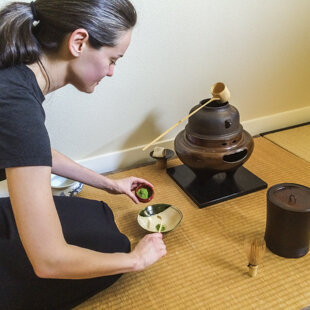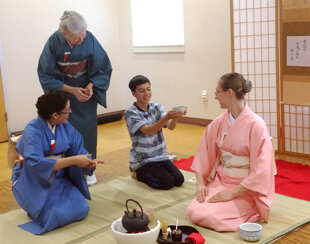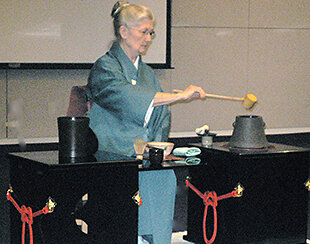CHADO and CHANOYU
CHADO 茶道 — The Way of Tea, is the lifelong practice of deepening understanding and refining the skills for creating Ichigo Ichie, one memorable moment in time, for one’s guests. The host, with a pure heart, follows the principles of Wa, Kei, Sei, and Jaku — Harmony, Respect, Purity and Tranquility, and fosters a deep appreciation of nature and the arts. Chado is not a religion, but is influenced by Zen Buddhism, Shinto, Taoism, Confucianism and Christianity.
CHANOYU 茶の湯 — “hot water for tea,” Japanese tea ceremony, is a 500 year-old tradition of social and aesthetic communion and universal hospitality which is central to Japanese culture. Within its formalized structure the host is free to vary the theme, degree of formality and choice of utensils to make each tea gathering a unique experience.
BENEFITS — both mental and physical. The meditative pace and focus on the moment develops awareness and gratitude for life. Each tea gathering is a new opportunity for aesthetic expression. Learning the various procedures for making tea exercises memory. Consuming matcha tea provides healthy antioxidants and a gentle, long-lasting stimulation from caffeine.
TEA CEREMONY / TEA GATHERING — an event where the host brings in the utensils for making tea, symbolically purifies them, makes and serves the tea, and then cleans and removes the utensils. The most formal chaji is about four hours long and includes a multi-course meal and a serving of both koicha and usucha (thick and thin matcha) with a confection. The least formal gathering for two or three guests includes only usucha with a confection, and takes less than one hour. There are also informal nodate (outdoor) tea gatherings held while viewing cherry blossoms, autumn colors, or the full moon.
RYUREI 立礼 or ritusurei-shiki, is the seating of host and guests at table and stools. This style of seating was developed by Gengensai Seichu Soshitsu in 1872, for those who are not able to sit in the traditional seiza 正座, or formal kneeling position on a tatami floor. See photos below of seiza and ryurei seating (modular table set designed by Linda Mosley).







